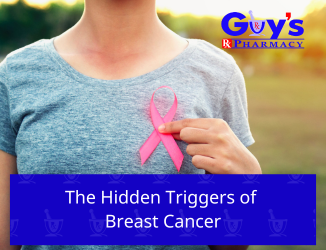Welcome to our four-part blog series on breast cancer prevention. While many conversations focus solely on genetics, there’s much more to the story. This series is your roadmap to understanding and reducing hidden risk factors—starting with everyday exposures and often-overlooked lifestyle triggers that may quietly increase your risk.
What are the major risk factors for breast cancer? Could it happen to you? Breast cancer isn’t just about family history. Environmental factors, inflammation, and metabolic imbalances all play a role.
Chronic Systemic Inflammation
Inflammation is a key contributing factor to the development of cancer, or abnormally growing cells in the body. This type of inflammation occurs throughout your body due to:
- Processed food exposure
- Gut imbalances
- Chronic stress
It’s not just illness, bacteria, or viruses that cause inflammation. Daily exposure to these stressors can compound over time, creating the conditions for disease to develop. To counter this, focus on anti-inflammatory foods that help restore balance to the gut. Supporting good bacteria can improve your immune system’s ability to fight off harmful invaders and reduce inflammation naturally.
Radiation Exposure
Radiation is a component of everyday life in various ways. Some of the most common exposures to radiation, a known cancer-causing toxin, include:
- Medical scans, including X-rays and mammograms
- Air travel screenings
- EMF exposure from mobile phones, power lines, phone towers, and other transmitters
Whenever possible, individuals need to minimize exposure to unnecessary scans and use protective measures when possible, such as the use of lead aprons to mitigate exposure.
Viral Infections and Cancer Risk
There are some noted viral infections with links to cancer. That includes HPV and Epstein-Barr, for example. Science has linked the presence of these viruses to a higher risk of developing life-threatening cancers.
The best way to minimize these risks of breast cancer development includes building a strong immune system through the use of a proper balance of sleep, nutrition, and stress reduction.
Intermittent Hypoxia (Low Oxygen Levels)
Another of the limitedly recognized risks of breast cancer development is the lack of enough oxygen on a routine basis. This may be due to poor breathing habits or sleep apnea, which reduces oxygen flow and promotes cancer cell growth.
Strategies for mitigating these risks include getting routine exercise to expand lung capacity, focusing on breathwork, and getting proper sleep, all of which improve oxygen levels in the body.
Chemical Carcinogen Exposure
Many everyday chemical exposures increase the risk of breast cancer development, including carcinogens found in:
- Cosmetics
- Plastics
- Processed foods
- Household cleaners
As you purchase and use these products, read the labels. Learn how to choose cleaner products that are less likely to include these cancer-causing agents. Switch to organic foods as well, as this reduces exposure. You have the right to improve your health, and with a visit to Guy’s Pharmacy, you’ll gain guidance on supplements that can help you. Check out our next blog, “The Metabolic Approach to Cancer Prevention,” to begin building strategies to protect your future.
Disclaimer: The content in this blog is for informational purposes only and is not a substitute for professional medical advice, diagnosis, or treatment. Always consult your healthcare provider with any questions regarding your health.

